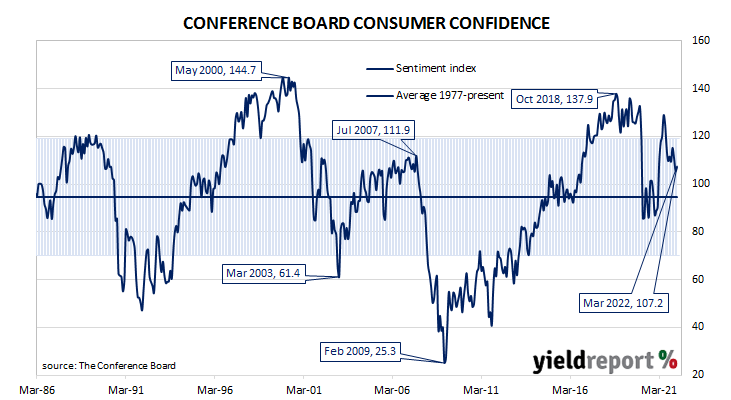Summary: Conference Board Consumer Confidence Index improves in March; reading essentially in line with consensus expectations; view of present conditions improve, short-term outlook deteriorate again; Present Situation Index suggests US economic growth should continue in March quarter; confidence bolstered by “strong employment growth”, holding up “remarkably well” despite Ukraine war, higher inflation expectations.
After the GFC in 2008/09, US consumer confidence clawed its way back to neutral over a number of years and then went from strength to strength until late 2018. Measures of consumer confidence then oscillated within a fairly narrow band at historically high levels until they plunged in early 2020. Subsequent readings then fluctuated around the long-term average until March 2021 when they reached elevated levels.
The latest Conference Board survey held during the first three weeks of March indicated US consumer confidence has improved a little. February’s Consumer Confidence Index registered 107.2 on a preliminary basis, a reading which was essentially in line with the median consensus figure of 107.8 but slightly above February’s final figure of 105.7.
As in February’s survey, consumers’ views of present conditions improved while their outlook for the near-future deteriorated. The Present Situation Index rose from February’ revised figure of 143.0 to 153.0 while the Expectations Index declined from a revised figure of 80.8 to 76.6.
Lynn Franco, a senior director at The Conference Board said the rise in the Present Situation Index suggests US economic growth should continue in the March quarter. However, he also noted how respondents had cited rising prices and the Ukraine war as factors behind their less optimistic outlook.
Short-term US Treasury yields moved higher while longer-term yields fell. By the close of business, the 2-year Treasury bond yield had gained 4bps to 2.37%, the 10-year yield had shed 6bps to 2.40% while the 30-year yield finished 5bps lower at 2.50%.
In terms of US Fed policy, expectations for a higher federal funds rate over the next 12 months softened. At the close of business, May contracts implied an effective federal funds rate of 0.725%, 40bps higher than the current spot rate. July contracts implied 1.25% and March 2023 futures contracts implied an effective federal funds rate of 2.66%, 233bps above the spot rate.
Franco suggested household confidence has been bolstered by “strong employment growth and thus has been holding up remarkably well” despite the war in Ukraine and higher inflation expectations.
The Consumer Confidence Survey is one of two monthly US consumer sentiment surveys which result in the construction of an index. The Conference Board’s index is based on perceptions of current business and employment conditions, as well as respondents’ expectations of conditions six months in the future. The other survey, conducted by the University of Michigan, is similar and it is used to produce an Index of Consumer Sentiment. That survey differs in that it also includes some longer-term questions.


